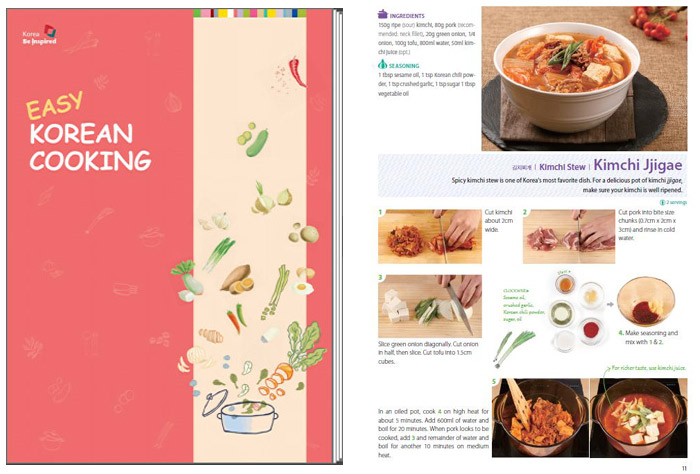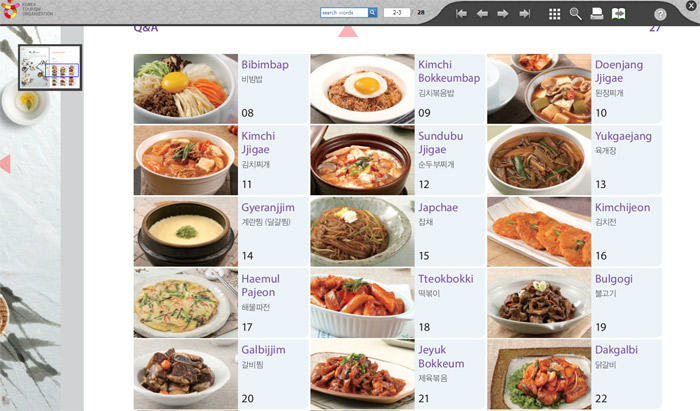-
 Korea.net's 24-hour YouTube channel
Korea.net's 24-hour YouTube channel- NEWS FOCUS
- ABOUT KOREA
- EVENTS
- RESOURCES
- GOVERNMENT
- ABOUT US

Hong Kong actor Jackie Chan said he loves yukgaejang, a style of spicy beef soup. Hollywood actress Gwyneth Paltrow made a video clip of herself cooking bibimbap, a mixed-rice dish with vegetables and meat. First Lady of the United States Michelle Obama tweeted her own recipe for kimchi using nappa cabbage she picked in the White House garden. These are some of the more popular Korean dishes that people enjoy around the world.
With the growing interest in Korean cuisine worldwide, the Korea Tourism Organization (KTO) recently published a cookbook of Korean recipes titled “Easy Korean Cooking.” The book is published in six languages: English, Japanese, German, French, simplified and traditional Chinese.

Unlike some existing Korean recipe books that introduce traditional cooking methods with local ingredients that can only be found in Korea, this book is designed to teach readers how to cook Korean dishes with ingredients and seasonings that are easy to find overseas. For those who do not have much experience cooking Korean, this book lets readers learn the basic elements of cooking first, ranging from the approximate size of ingredients to measuring, making soup stock, juices, cutting and, of course, how to make rice.
The book introduces 18 recipes for popular Korean dishes, including: bibimbap, kimchi jjigae, japchae, stir-fried glass noodles with vegetables, bulgogi, grilled marinated beef, tteokbokki, rice cake in a chilly pepper sauce, yukgaejang and baechu kimchi, the traditional Korean fermented side dish made with nappa cabbage and vegetables. It gives step-by-step directions with detailed instructions and photos so that readers can easily follow each step of the process.
The book also provides useful information about Korean cooking in its Q&A section at the end. For example, it informs readers which cuts of beef are good for bulgogi, and whether pre-boiling rice cake is a good idea when making tteokbokki. The book also contains answers to questions such as which oil is commonly used in Korean recipes and whether one whole chicken should be used when making samgyetang, a chicken-based soup with rice and ginseng.

The KTO will provide the book for free at its 30 overseas offices, its tourism information centers and at related organizations in Korea. It also provides an e-book format of the book at its homepage www.visitkorea.or.krFinaly people can download the "K-Book" application at either Google Play or at Apple's App Store to read the e-book on their smartphone or tablet.
By Yoon Sojung
Korea.net Staff Writer
arete@korea.kr
With the growing interest in Korean cuisine worldwide, the Korea Tourism Organization (KTO) recently published a cookbook of Korean recipes titled “Easy Korean Cooking.” The book is published in six languages: English, Japanese, German, French, simplified and traditional Chinese.

(From left) The cover of the e-book version of “Easy Korean Cooking,” a cookbook that introduces recipes of popular Korean dishes, published by the KTO; In the above recipe, “Easy Korean Cooking” tells the reader how to make kimchi jjigae, a spicy kimchi and pork stew, with detailed photos of each step.
Unlike some existing Korean recipe books that introduce traditional cooking methods with local ingredients that can only be found in Korea, this book is designed to teach readers how to cook Korean dishes with ingredients and seasonings that are easy to find overseas. For those who do not have much experience cooking Korean, this book lets readers learn the basic elements of cooking first, ranging from the approximate size of ingredients to measuring, making soup stock, juices, cutting and, of course, how to make rice.
The book introduces 18 recipes for popular Korean dishes, including: bibimbap, kimchi jjigae, japchae, stir-fried glass noodles with vegetables, bulgogi, grilled marinated beef, tteokbokki, rice cake in a chilly pepper sauce, yukgaejang and baechu kimchi, the traditional Korean fermented side dish made with nappa cabbage and vegetables. It gives step-by-step directions with detailed instructions and photos so that readers can easily follow each step of the process.
The book also provides useful information about Korean cooking in its Q&A section at the end. For example, it informs readers which cuts of beef are good for bulgogi, and whether pre-boiling rice cake is a good idea when making tteokbokki. The book also contains answers to questions such as which oil is commonly used in Korean recipes and whether one whole chicken should be used when making samgyetang, a chicken-based soup with rice and ginseng.

“Easy Korean Cooking” has 18 color photo recipes for some of the most popular Korean dishes.
The KTO will provide the book for free at its 30 overseas offices, its tourism information centers and at related organizations in Korea. It also provides an e-book format of the book at its homepage www.visitkorea.or.krFinaly people can download the "K-Book" application at either Google Play or at Apple's App Store to read the e-book on their smartphone or tablet.
By Yoon Sojung
Korea.net Staff Writer
arete@korea.kr













